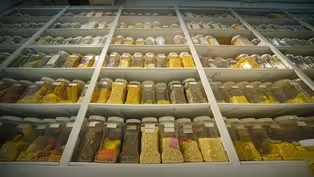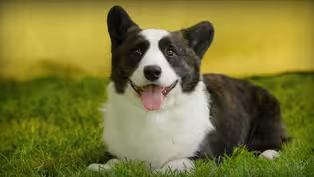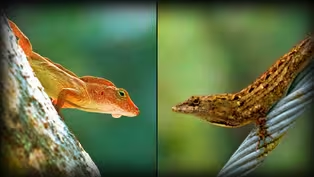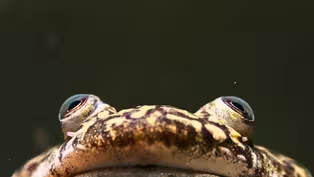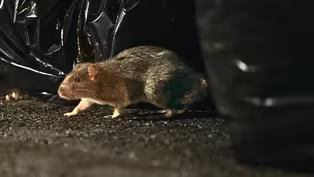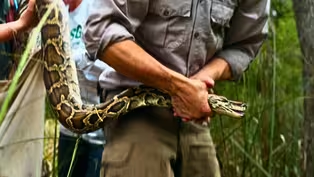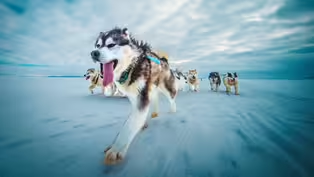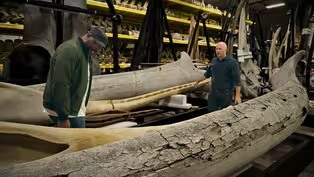
Your Cat’s Secret Life (as a Deadly Predator)
Special | 10m 40sVideo has Closed Captions
Cats have been winning the hearts of humans for years....but can devastate ecosystems.
Our adorable companions are extremely efficient hunters, with the ability to devastate ecosystems and decimate wild prey populations. Get the scoop when Shane Campbell-Staton meets the scientists behind the largest animal tracking study that is hoping to curb this problem - and meet a few charming felines along the way in this episode of Human Footprint.
Problems playing video? | Closed Captioning Feedback
Problems playing video? | Closed Captioning Feedback

Your Cat’s Secret Life (as a Deadly Predator)
Special | 10m 40sVideo has Closed Captions
Our adorable companions are extremely efficient hunters, with the ability to devastate ecosystems and decimate wild prey populations. Get the scoop when Shane Campbell-Staton meets the scientists behind the largest animal tracking study that is hoping to curb this problem - and meet a few charming felines along the way in this episode of Human Footprint.
Problems playing video? | Closed Captioning Feedback
How to Watch Human Footprint
Human Footprint is available to stream on pbs.org and the free PBS App, available on iPhone, Apple TV, Android TV, Android smartphones, Amazon Fire TV, Amazon Fire Tablet, Roku, Samsung Smart TV, and Vizio.
Buy Now

Surprising Moments from Human Footprint
Do you think you know what it means to be human? In Human Footprint, Biologist Shane Campbell-Staton asks us all to think again. As he discovers, the story of our impact on the world around us is more complicated — and much more surprising — than you might realize.Providing Support for PBS.org
Learn Moreabout PBS online sponsorshipMore from This Collection
Human Footprint is a show that delves into the impact of humans on the planet. Join Shane as he travels from farms to restaurants, from high-tech labs to street markets, and from forests to cities to uncover the consequences of our unique history. Are you ready to explore our past, present, and future as a species?
Video has Closed Captions
Watch the rise of a productive crop that has managed to replace itself, but at what cost? (11m 24s)
The Watery Price Of Golf Courses & Lawns
Video has Closed Captions
The cultural and resource costs for manicured lawns and golf courses are quite shocking. (11m 29s)
How Dogs Are Shaping The Future Of Medicine
Video has Closed Captions
Observe the rich diversity of dog breeds, shaped by genes and human intervention. (12m 43s)
We Brought This Fish To America. Now We Can't Get Rid Of It
Video has Closed Captions
Expose Asian carp for disrupting native fish species and shrinking their populations. (10m 39s)
Why Are These Urban Lizards Evolving in Overdrive?
Video has Closed Captions
Examine city-dwelling anoles with remarkable evolutionary changes. (10m 33s)
How An Ancient Ocean Shaped Us History
Video has Closed Captions
Learn how millions of years of deposits shaped the events of Black American history. (16m 54s)
Video has Closed Captions
What happens when frogs become indispensable? (8m 59s)
Video has Closed Captions
When it comes to NYC, the rat is the undisputed king! (13m 26s)
Singapore: Designing a Megacity in Harmony with Nature
Video has Closed Captions
Green spaces aren't just an afterthought here - they're mandatory! (13m 24s)
How Giant Pythons Became Florida’s Biggest Invasive Species
Video has Closed Captions
Ever heard of the phrase "when pet pythons outgrow their owners"? (13m 24s)
Sled Dogs: The Most Extreme Distance Athletes on Earth
Video has Closed Captions
In the Arctic, it's not just about muscle power, but brainpower too. (15m 17s)
Secrets of the World’s Only Whale Warehouse
Video has Closed Captions
Uncover the history of whaling and its impact on our oceans. (9m 58s)
Providing Support for PBS.org
Learn Moreabout PBS online sponsorshipI am NOT a cat person, but I gotta say, cats are kinda crushing it out there.
All over the world, cat populations continue to grow while most wild predators are in steep decline.
Apart from dogs, cats are the most abundant predatory mammals the world has ever seen.
There are between 600 million and a BILLION domestic cats in the world.
But here’s the thing: we actually have no idea what cats are doing when we are not around.
Which is a pretty typical cat thing, right?
So I met up with some scientists conducting not only the biggest study of cat movement in the world, but the largest tracking study of any species - to find out what exactly cats are doing out there.
I’m Shane Campbell-Staton, and this is Human Footprint.
You actually own cats.
I– We have four cats here in the house.
I'm not sure own is the proper verb.
Okay, hahaha.
But they live here.
And they run the show, put it that way.
In the biology world, Jonathan is a legend for his research on lizards.
But outside the lab, cats are his passion.
I’ve always been into cats, but it never occurred to me to do anything professionally with them, because they’re just cats!
But he just couldn’t help himself.
And now, he’s written a whole book on the science of cats.
So how do we get from the truly wild cat to these guys that are running around your house?
The idea is this: that when humans adopted an agricultural lifestyle, we started raising crops and storing them; and that of course attracted rodents, and this was in the native range of the African Wild Cat.
These wild cats started hanging around human settlements.
The less afraid of us they were, the better they did.
Over time, cats evolved to be friendlier, or at least more tolerant of human company.
We started appreciating them too, and soon, we were bringing them with us around the world.
Let me see one of these cats.
All right.
I'll go get one right here.
He's in his little basket over here.
It's showtime, Nelson.
This is Nelson.
He's the one on your mug.
Let me see what all this noise is about.
Now if I look uncomfortable here, it’s because I'm very allergic to cats.
A key phase in domestication, in general, is when humans take over the breeding process.
Cats became semi-domestic simply by hanging around and catching mice.
It’s only for the last few hundred years that we've controlled who mated with whom, producing dozens of distinct breeds…like the American Burmese in my lap.
Here you go Nelson, I’ll put you back in your basket.
I know I'm going to pay for that later.
So you mentioned that a couple of your cats are inside/outside cats.
When they're out cruising, do you have any idea what they're doing out there?
Well, mostly no.
He says, "None of your business is what I'm doing out there."
Cats would be appalled to know that researchers are working hard to uncover their secret lives outdoors.
Roland Kays knows more about animal tracking than almost anyone on the planet.
What he gets up to in his own time… that’s his business.
Hey, welcome.
Hey, how's it going?
Thank the good Lord for antihistamines.
‘Cause this was not in my contract.
Is this not the perfect place to talk about cats?
There's definitely a lot of cats in here.
It's a cat coffee shop.
And if you want to, you can walk out of here with your very own cat.
Okay.
I… will pass, but I appreciate the sentiment.
You know you’ve got too many cats when you start giving them away for free.
When cats go out, cats hunt, right?
I mean this is why we domesticated them in the first place.
One cat catching a few things isn't a big deal, it's when you magnify that by 600 million, then all of a sudden, maybe it is a big deal… The problem is, scientists know next to nothing about what cats do in the wild, or what their impact might be.
Roland’s answer?
Track cats the way we track wild predators – by fitting them with GPS-enabled collars.
Several of those cats were right here in Raleigh, including a cat named Kraken.
Hello.
Hey, how are you?
Good, how are you?
Come on in.
So she came to us as a stray in the summer, before we decided to … bring her inside.
Is it like a mystery to you what her life is like out there?
Oh, yeah.
Absolutely.
I found out about Mohammed's study, and so we signed her up.
So this is the tracker that we are using on the cats.
What we have here is the microchip that has both the accelerometer and the GPS.
The accelerometer measures the cat's movement - left-right, forward-reverse.
And the GPS tells us where the cat is.
We save the data on the collar, then we retrieve it from the animal.
Then connect it to a computer to download the saved data here.
So a cat has to bring you the data back?
Yeah.
With this study, what will we know about the lives of these cats that we didn't know before?
Well, one of the things that we're hoping the more detailed data will show us is, where exactly they're going and what habitats they're using, how often they're crossing streets, for example.
And if they're going into the natural areas where they might on one hand encounter a coyote or something scary, but also could potentially be hunting native species that would be more concerned about out in a more natural area than compared to the more neighborhood urban area.
So understanding exactly where the cats go and also what their behavior is.
Cool.
So should we release the Kraken?
I'm so glad I got to say that.
I think this is Kraken right here… It went down here to this house, and then it came back, and you can see one trek way over there.
That was a bit of a surprise.
Roland’s study isn’t just the biggest study of cat movement in the world - it's the largest tracking study of any species.
Roland sent GPS collars to collaborators all over the world.
So this is just a map of the earth, and I've got pink dots anywhere that we were tracking cats.
So, we've got Allie, Aley, Amber Rose, Amelia, just A to Z probably we've got all kinds of different ones.
It turns out, most cats don’t stray too far from home.
Our average across all 900 cats was 3.5 hectares.
That’s about six or seven football fields.
The next thing we had to figure out is, how do we put that into perspective?
Roland compared data from domestic cats to their closest wild relatives.
What we found was that the domestic cats have a four to ten times more ecological impact on their prey than do wild species, but that's going to be concentrated within basically 100 meters of someone's house.
One of their biggest footprints can be seen on migrating bird populations.
There are some estimates in the United States that cats kill sort of one to three billion birds a year.
Billion.
Yes.
But it’s even more small mammals.
It’s like 7-10 billion small mammals.
And the impacts of cats in places like Australia, New Zealand, and oceanic islands have been devastating.
There are examples of animals that have been completely hunted to extinction by cats.
Some biologists consider them the worst invasive species alive.
But Roland’s got a plan to curb the impact of these cuddly killers.
It could start by adding an accelerometer to our cats’ collars.
The accelerometer basically measures the orientation and the movement of the collar in three dimensions.
So now, here's the three axes, X, Y, and Z axis, and you can see they're very flat.
That means the animal's resting.
So here, you can see, see how rhythmic this is.
Choo-choo-choo-choo-choo-choo-choo-choo-choo.
So that's a walking or running cat.
If the accelerometer can recognize a walking or running cat, what else can it tell us?
And so what our goal is, is to get artificial intelligence algorithms on the collar recognizing, this cat's about to hunt.
One of the amazing things, so birds have alarm calls, and they listen to each other.
So they know, like a chickadee knows the alarm call of the titmouse.
So we could have basically a bird alarm call go off on the cat's collars and all the birds would be alerted, "Look out, predator here."
It seems an ingenious solution, but the flip side is that also, cats learn.
Is it possible that cats will just learn to hunt a different way?
I'd say it's highly possible that I would be outsmarted by a cat, yes.
Because cats learn.
If you give a cat a bell, it learns how to walk without triggering the bell.
And so, it’s possible that it could figure out that when it does a certain thing, there’s this noise that comes from its collar.
I don’t know.
We'll have to wait and see.
But I guess the difference is that the bell doesn't have the ability to adapt to the cat.
Exactly.
Exactly.
But an AI potentially has the ability to adapt and learn along with the cat.
Yup, yeah.
That's brilliant.
That’s really cool.
We’ve made a pact with cats.
Even as they deplete the natural world around us, they seem to enrich another part of our lives.
Sure, their modern existence can be pretty bizarre, and damn do they make my eyes itch… But compared to their wild relatives, one thing’s for sure: cats are evolutionary winners.
If you want more Human Footprint, you can tune in to the full length series on the PBS App or on your local PBS station.

- Science and Nature

Explore scientific discoveries on television's most acclaimed science documentary series.

- Science and Nature

Capturing the splendor of the natural world, from the African plains to the Antarctic ice.












Support for PBS provided by:
